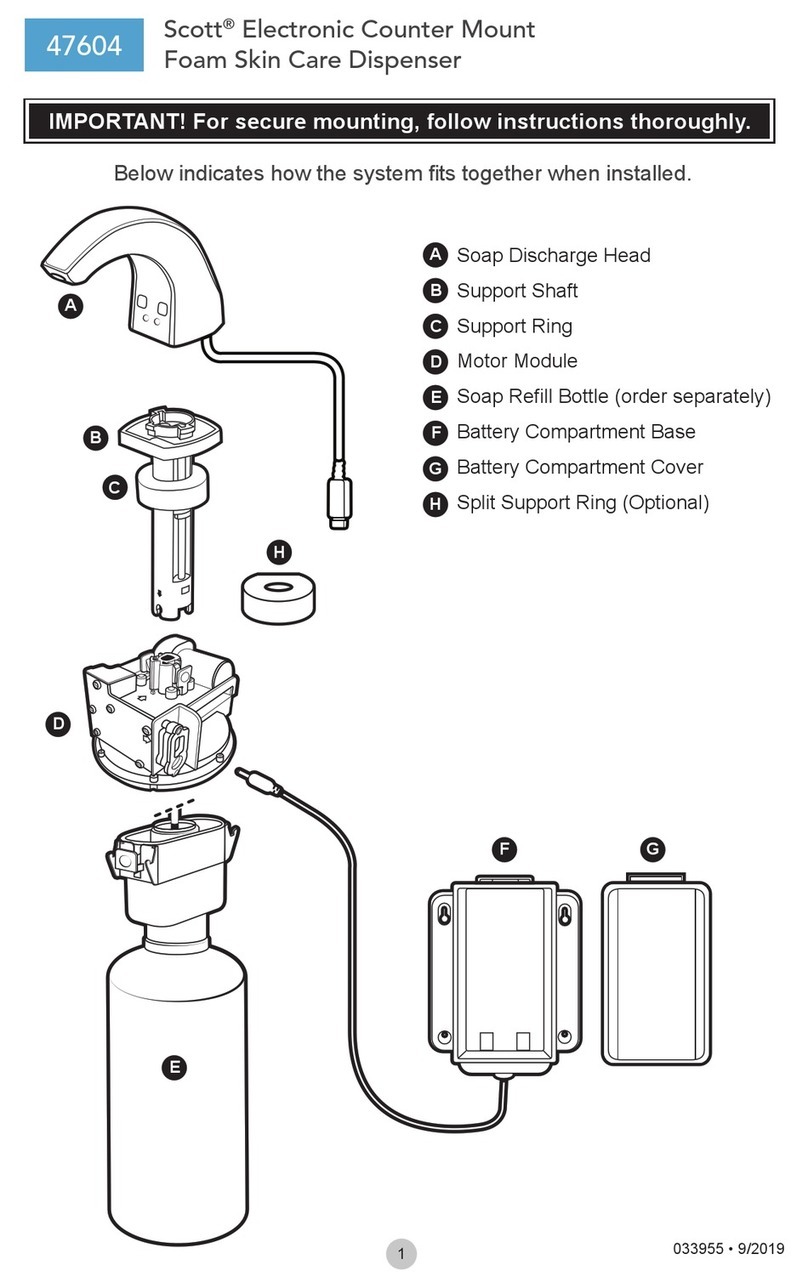
© 2019
GOJO Industries, Inc. All Rights Reserved
Defaults
The default settings for the mod
ule board are as follows:
Synchronization Interval: 60 minutes (may be set to any value [30
Dispense Count Threshold: 50 dispenses (may be set to any value [5
Device Compliance
Onvation Module FCC/IC Label
Please include on dispenser packagin
g or enclosure the following:
"Contains FCC ID: O76ONVATION, IC: 10391B
This equipment has been tested and found to comply with the limits for a Class A digital device, pursuant to part 15 of
the FCC rules. These limits are designed to provide re
equipment is operated in a commercial environment. This equipment generates, uses, and can radiate radio
frequency energy and, if not installed and used in accordance with the instruction manual, ma
interference to radio communications. Operation of this equipment in a residential area is likely to cause harmful
interference in which case the user will be required to correct the interference at his own expense.
This device complies wit
h Part 15 of the FCC rules. Operation is subject to the following two conditions. (1) This
device may not cause harmful interference, and (2) This device must accept any interference received, including
interference that may cause undesired operation.
Cha
nges or modifications not expressly approved by the party responsible for compliance could void the user's
authority to operate the equipment
This device complies with Industry Canada license
conditions: (1) this device may not cause interference, and (2) this device must accept any interference, including
interference that may cause undesired operation of the device.
Le présent appareil est conforme aux CNR d’Industrie Canada applicables aux
L’exploitation est autorisée aux deux conditions suivantes: (1) l’appareil ne doit pas produire de brouillage, et (2)
l’utilisateur de l’appareil doit accepter tout brouillage radioélectrique subi, même si le brouillage
compromettre le fonctionnement.
This device complies with Part 15 of the FCC rules. Operation is subject to the following two conditions. (1) This
device may not cause harmful interference, and (2) This device must accept any interfe
interference that may cause undesired operation.
GOJO Industries, Inc. All Rights Reserved
ule board are as follows:
Synchronization Interval: 60 minutes (may be set to any value [30
-720])
Dispense Count Threshold: 50 dispenses (may be set to any value [5
-255])
g or enclosure the following:
"Contains FCC ID: O76ONVATION, IC: 10391B
-ONVATION"
This equipment has been tested and found to comply with the limits for a Class A digital device, pursuant to part 15 of
the FCC rules. These limits are designed to provide re
asonable protection against harmful interference when the
equipment is operated in a commercial environment. This equipment generates, uses, and can radiate radio
frequency energy and, if not installed and used in accordance with the instruction manual, ma
interference to radio communications. Operation of this equipment in a residential area is likely to cause harmful
interference in which case the user will be required to correct the interference at his own expense.
h Part 15 of the FCC rules. Operation is subject to the following two conditions. (1) This
device may not cause harmful interference, and (2) This device must accept any interference received, including
interference that may cause undesired operation.
nges or modifications not expressly approved by the party responsible for compliance could void the user's
This device complies with Industry Canada license
-
exempt RSS standard(s). Operation is subject to the following tw
conditions: (1) this device may not cause interference, and (2) this device must accept any interference, including
interference that may cause undesired operation of the device.
Le présent appareil est conforme aux CNR d’Industrie Canada applicables aux
appareils radio exempts de licence.
L’exploitation est autorisée aux deux conditions suivantes: (1) l’appareil ne doit pas produire de brouillage, et (2)
l’utilisateur de l’appareil doit accepter tout brouillage radioélectrique subi, même si le brouillage
This device complies with Part 15 of the FCC rules. Operation is subject to the following two conditions. (1) This
device may not cause harmful interference, and (2) This device must accept any interfe
rence received, including
interference that may cause undesired operation.
Page 7of 7
This equipment has been tested and found to comply with the limits for a Class A digital device, pursuant to part 15 of
asonable protection against harmful interference when the
equipment is operated in a commercial environment. This equipment generates, uses, and can radiate radio
frequency energy and, if not installed and used in accordance with the instruction manual, ma
y cause harmful
interference to radio communications. Operation of this equipment in a residential area is likely to cause harmful
interference in which case the user will be required to correct the interference at his own expense.
h Part 15 of the FCC rules. Operation is subject to the following two conditions. (1) This
device may not cause harmful interference, and (2) This device must accept any interference received, including
nges or modifications not expressly approved by the party responsible for compliance could void the user's
exempt RSS standard(s). Operation is subject to the following tw
o
conditions: (1) this device may not cause interference, and (2) this device must accept any interference, including
appareils radio exempts de licence.
L’exploitation est autorisée aux deux conditions suivantes: (1) l’appareil ne doit pas produire de brouillage, et (2)
l’utilisateur de l’appareil doit accepter tout brouillage radioélectrique subi, même si le brouillage
est susceptible d’en
This device complies with Part 15 of the FCC rules. Operation is subject to the following two conditions. (1) This
rence received, including

























